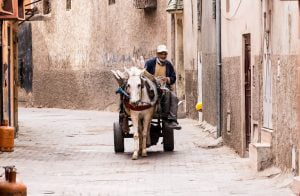
9 days desert tour from Casablanca
9 days desert tour from Casablanca Morocco Expedition offer a 9 days desert excursion from Casablanca. With a few clicks, you’ll be About This Tour Destination
Are you planning a trip to Morocco soon? Check out our Morocco 6 days travel itinerary from Casablanca.
Our 6 days travel itinerary from Casablanca to Marrakech through the Merzouga Sahara desert is a great way to see the highlights of our nation. The journey will begin in Casablanca. We will visit Fes and provide you with a guided tour with a local guide who will accompany you and explain the city’s history.
The desert of Merzouga, the centerpiece of all our Morocco excursions, will be our next stop. We’ll stop at Ifrane, Azrou, and Ziz Valley along the route. When you arrive at Merzouga, you will have the opportunity to participate in a variety of activities such as camel riding, camping, and meeting the Gnaoua people, among others.
Following that, we shall visit such lovely locations. We’ll see the Todgha and Dades gorges, as well as the city of cinema, Ouarzazate, and the Berber citadel of Ait Benhaddou. Our six-day journey from Casablanca will conclude in Marrakech, Morocco’s most visited city.
Our 6 days travel plan from Casablanca to Marrakech will begin in Morocco’s largest city, Casablanca. If you come early, you will have the opportunity to see Hassan II’s mosque, Morocco’s largest and the seventh largest in the world. Following that, we will go to Rabat, Morocco’s capital city. We will next proceed to the Hassan Tower and the Kasbah of Les Oudayas. The latter is situated on the Rabat estuary’s southern bank. With its blue and white walls, this structure stands out.
In addition, we will explore the Chellah Marinid necropolis. Later, we’ll go to Fes and spend the night in one of the city’s riads.
On this day of our 6-day vacation from Casablanca, we’ll visit Fes with a local guide. To begin, we shall explore the historic Medina of Fes el Bali from the outside. We will next visit the Royal Palace, which has seven golden gates. Following that, we’ll drive to the Borj Nord for a spectacular panoramic view of the whole city. This location is on a mountain.
Following that, we will visit al Quaraouiyine Institution, which is recognized by Guinness World Records and UNESCO as the world’s oldest continuously functioning university. Finally, we’ll go to the Chouara tannery, the biggest of the four medieval tanneries that still stand in Fes’ medina. Stay the night at a local riad.
The Merzouga desert will be the focus of our Morocco tours on the third day of our 6-day travel itinerary from Casablanca. We’ll make a few stops along the trip to explore some fascinating locations and attractions. First and foremost, we will visit Ifrane, the cleanest city in the whole nation. We’ll go view the Atlas Lion monument and learn about its fascinating tale. We will next proceed to the Cedar Forest, which is home to the Barbary Macaque. You’ll be able to feed them and snap some great photos.
Our next destination will be Ziz Valley. Oued Ziz cuts through a big expanse of palm palms. You will have the opportunity to snap some beautiful photographs there. Later, we will arrive in Merzouga Sahara desert and transport you to your hotel to rest.
On the fourth day of our six-day vacation from Casablanca, we will visit the Merzouga Sahara desert. We’ll start by going to the Morocco National 4X4 Auto Museum, which has some amazing antique automobiles. Then we’ll go to Khamlia to listen to Gnaoua music performed by locals. Following that, we’ll go to the Mifis mine, where people used to extract salt and mascara. We’ll then go to see a Berber family that still lives in a tent. We’ll meet them and observe how they live.
The lake of Srij will be our next stop. It is a stopover for migrating birds such as ducks and flamingos. It is also an excellent location for photographing Merzouga’s little settlements. Following our tour to Srij Lake, we will go to the Hassi Labied Oasis. Later in the day, we will transport you on camel over the Erg Chebbi desert to a Berber camp to spend the night. Our crew will sit by the fire and play drums for you.
On this day of our 6-day vacation plan from Casablanca to Marrakech, we’ll take the road to see the Dades gorges’ spectacular canyons. On the route, we’ll observe a historic irrigation system in the Fezna area. Then we’ll pay a visit to a Berber clothing cooperative. Following that, we will go to Todgha goges, which are located 15 kilometers from Tinghir. With its huge limestone cliffs, they are the gateway to the High Atlas Mountains.
The Dades gorges will be the next stop. We’ll go visit the monkey toes, a geological structure that looks like a monkey’s fingers. We shall also observe Tisdrine’s curves. Spend the night in Dades.
On the last day of our 6-day vacation from Casablanca to Marrakech, we will see several fascinating sights along the road. To begin, we shall visit Kelaat Megouna’s rose valley. Then we’ll take the route to Ouarzazate to view the Atlas film studios. Following that, we will visit the Kasbah of Ait Benhaddou, a renowned Berber castle in Morocco that has been featured in several films and television series.
At the conclusion of the day, we’ll travel over the high Atlas highlands to the red city of Marrakech through the Tichka passes. We will pause around 2260 meters for a beautiful panoramic view from the peak. If you want to purchase anything, we can make another trip at a cooperative argan oil. After that, we’ll arrive in Marrakech and transfer you to the airport or your hotel. This concludes our 6-day vacation plan from Casablanca to Marrakech through the Merzouga Sahara desert.
I had never been to Morocco before, and this trip made sure we got the most out of it. We took three ladies on a 6-day excursion from Casablanca to Marrakech, and everything was flawlessly coordinated from start to end. The hotels were excellent, the cuisine was delicious, and we were free to do and see anything we pleased.
The scenery is stunning, and there was plenty of time to snap photos. On top of that, we had our fantastic driver Youssef who informed us about the nation and answered all of our questions. hassan, we already miss you! I’ve never had a better road trip and would suggest it to anybody. IT WAS FANTASTIC!
We scheduled a Desert Tour in Merzouga beginning in Casablanca. My buddy, brother-in-law, and I were picked up from the hotel and driven across the country in the 4WD. I’ve looked at several Bedouin tents, ranging from the most basic to the most magnificent. A stunning view of the beach, mountains, and sky. There were a lot of camels, donkeys, sharps, and rally drivers. Tea was had in one of the tents where a folk dance was performed, and traditional meal was consumed in another tent (very tasty).
Everything, including the history, was taught to us by our guide. He responded to all of our inquiries. We stopped at several locations to take photographs. Overall, it was incredibly thrilling and informative, a lot of fun, and well worth the money. I will undoubtedly be delighted to return!
It was a fantastic vacation; first and foremost, we could sense Touring in Morocco’s patience in email conversation, and we confirmed the trip after several discussions. Youssef met us at the train station and drove us to our hotel on the day we arrived in Casablanca, which was a terrific start.
Youssef was incredibly polite and attentive throughout the procedure, making us feel cared for and comfortable while we were traveling outdoors. We were able to freely discuss meals, lodging, and transportation with him. We were dropped off in Marrakech later, and he was kind enough to accompany us to purchase our remaining tickets for the trip, which was fantastic.
Please feel free to contact us if you have any concerns about the 6 Days travel from Casablanca to Marrakech itinerary. Any inquiries you may have will be answered with pleasure by our staff.
Anfa’s old city has weathered several foreign invasions throughout the years. Casablanca, as it is now known, has a long and distinguished history in North Africa. Many centuries later, when the Amazighs, Romans, and Portuguese took over, Anfa was turned into Dar el Beida.
Casablanca went through many phases throughout the years before becoming one of Africa’s major metropolises and Morocco’s largest agglomeration. Anfa, a historic Berber city founded in the 10th century BC, is today the economic hub known as Casablanca. Anfa is a Berber name that means “small hill,” according to the UNESCO book “Africa Ethnonyms and Toponyms.”
Casablanca has seen several transformations throughout the centuries. From the third century BC to 40 AD, the land that is now Morocco, Algeria, and Tunisia was called “Mauritania.” This was because the Amazigh people lived there and were in charge.
According to Roman Heritage, a non-profit cultural site dedicated to ancient Rome, the Amazigh, commonly known as “Berbers,” controlled northern Morocco. This story says that there were semi-nomadic Berber tribes in northern Morocco, Algeria, and the Spanish cities of Ceuta and Melilla.
Due to its urban history and contemporary dynamics, Fes, situated on the Sais plateau at the crossroads of northern Morocco, serves as a reference model in the geography of “margins” and “marginalization.” Throughout the twentieth century, Fes, the kingdom’s prior political and economic hub, was relegated to a small regional center. Today, however, this city hopes to be among the world’s third-millennium cities.
Fes is a crossroads city on the old caravan routes that linked sub-Saharan Africa, the Arab-Muslim East, and the northern Mediterranean during the Middle Ages.
A glance at an early twentieth-century toponymic map of Fes demonstrates that the city’s settlement history is defined by periodic migrations. Fes had a Berber population. But over time, Arab families from Andalusia, Kairouan, Tlemcen, and other Muslim countries joined this group.
According to legend, Christianity first spread over the area in the third century. Hebrews would have arrived in Fes as early as the 10th century. Beginning in the 16th century, the inflow of people from Sub-Saharan African countries reinforced this colony. As a result of this invasion, Fes became a place where people from Islam, Judaism, and Christianity could meet and share ideas.
Merzouga is a village in southern Morocco on the Algerian border, at the entrance to the Sahara Desert, about 200 kilometers from Tinghir and 350 kilometers from Ouarzazate. Merzouga is primarily famed for its world-renowned sand dunes.
It is located at the entrance to the Erg de Chebbi, which has some of the most spectacular dunes in the Sahara as well as Morocco’s tallest permanent dunes. It is Morocco’s only erg, along with the Erg of Chegaga (or Chigaga). Merzouga is one of the last towns in Morocco before the Sahara. It is about fifty kilometers from the border with Algeria.
Merzouga is a desert region with a severe, hot, and dry environment. The average temperature in the summer may reach 45 degrees and 25 degrees in the winter, but it can drop to around zero degrees at night in both seasons. So keep a warm item in your luggage in mind.
Precipitation is rare, but when it does fall, it is frequently heavy and stormy. Merzouga has minimal bad weather and always has a clear sky, both during the day and at night, making it ideal for stargazing.
The Dayet Srij lake, which can be seen after traversing the massive dunes, is just a few kilometers from Merzouga. It offers a spectacular view of the dunes as well as exceptional fauna. The peace that exudes from this amazing place will captivate you. What a sight to witness pink flamingos or white storks slowly soaring over the blue of the lake, with the magnificent Merzouga dunes in the background. This unusual terrain has a captivating beauty. It’s rare to find a lake at the edge of the desert.
Ouarzazate is located at the confluence of the Ouarzazate and Dades valleys (both from the High Atlas), which form the Draa river downstream. It is the nerve center for a significant portion of southern Morocco. Ouarzazate suggests both the southern slopes of the High Atlas and the desert’s closeness.
Ouarzazate has a dry environment with an annual rainfall of just 112 mm. In the summer, rainfall is light and sporadic, if not non-existent. Temperatures are pleasant at night in the winter and intense during the day in the summer. The plant cover is minimal, and cultivation is only viable because the Oued Drâa’s waters are used to irrigate agricultural areas.
The city’s icon is the Taourirt Kasbah, which belonged to Pasha El Glaoui and was erected in the middle of the 18th century. It is next to the medina and is shown on the new 50 dirham banknotes.
Morocco boasts an abundance of kasbahs. The most famous and visited is the Kasbah fortification of Ait Benhaddou. This property has been recognized as a Unesco World Heritage Site since 1987. The Kasbah, on the other hand, dates back to the 11th century and was built by the Glawi family.
Furthermore, the caravans of Touareg nomads who used to travel for 52 days from Tombouctou are well-known in this region. They came here to sell salt since the region has a river named Oued El Maleh, where Oued refers to the river and Maleh refers to the salt.
There are around 7 storeys in that location, each with many clay and mud dwellings. The main one is at the top, and it used to be where they kept the salt for other visitors who wished to exchange it.
This area has been used to shoot a variety of films and movies. For example, iconic films like Gladiator and Lawrence of Arabia were filmed there.
Marrakech is Morocco’s most popular tourist destination. As a consequence of its hue, it is also known as the tourist city and the red city. This huge and picturesque city is one of Morocco’s four imperial cities. It was created in 1062 by Yusuf Ibn Tashfin.
The Jemaa el Fnaa plaza in Marrakech is well-known. In reality, there are snake charmers and people doing “street entertainment” there. Since it is the city’s market, or souk, you may find people selling many different things.
The Koutoubia mosque is not far from the heart of Jemaa el-Fnaa. It is also known as Kutubiyya and is the largest mosque in Marrakech, with a 773 meter tall tower. Non-Muslims are not allowed to enter. Only the Hassan II Mosque in Casablanca permits this.
In Marrakech, there is a magnificent garden called Majorelle. This art gallery was produced and dedicated to Morocco by the French artist John Jacques Majorelle. Also, bear in mind that this French artist worked on this garden for about 40 years.
Different cities in Morocco are included in our tailor-made itineraries. But if you want to organize your own, just let us know.

9 days desert tour from Casablanca Morocco Expedition offer a 9 days desert excursion from Casablanca. With a few clicks, you’ll be About This Tour Destination

4 days tour from Casablanca to Marrakech Morocco Expedition offer a 4 days journey from Casablanca to Marrakech. About This Tour Destination : Marrakech Start From
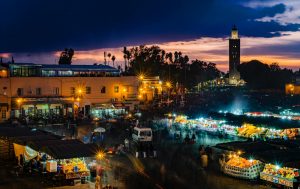
This Morocco desert trip itinerary is customized for 5 days from Casablanca to Marrakech. Are you going to Morocco? Check out our 5 day Morocco
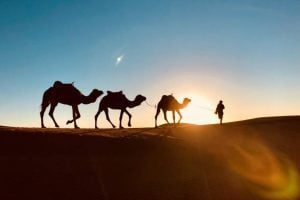
Morocco itineraries for two weeks starting in Casablanca Join us on a 2-week journey across the Sahara desert in Morocco. About This Tour Destinations :

Morocco 12-day tour from Casablanca Itinerary for 12 days. Please note that alterations to this itinerary may also be made in Tangier, marrakech, fes. About
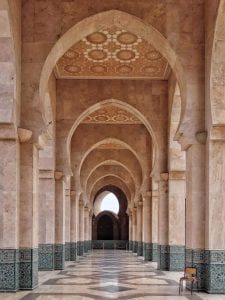
Morocco itinerary 10 days tour from casablanca. Itinerary for 10 days Morocco tour from Casablanca. Note: This tour itinerary is customizable with our Marrakech desert tours, Fes desert tours, and Tangier
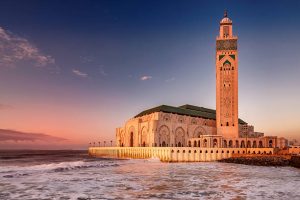
Customized 8 days Morocco tour itinerary from Casablanca Morocco Expedition provides an itinerary for a visit of Morocco lasting 8 days that begins in Casablanca.
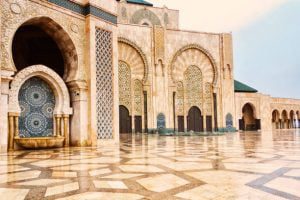
7 days tour from Casablanca – Morocco one week itinerary Tour of Morocco’s one week itinerary departing from Casablanca for seven days. Make reservations for